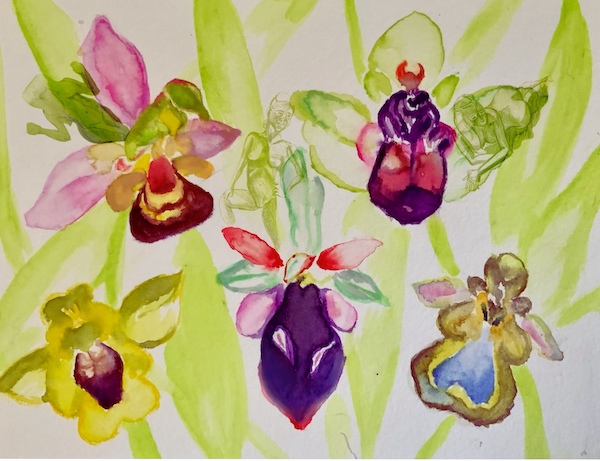
Illustration by Sarah Zeichner for Caltech Letters
Viewpoint articles are a vehicle for members of the Caltech community to express their opinions on issues surrounding the interface of science and society. The views expressed here do not necessarily reflect the views of Caltech or the editorial board of Caltech Letters. Please see our disclaimer.
There are such queer things about orchids. Such possibilities of surprises.
—“The Flowering of the Strange Orchid” H.G. Wells, 1894
In 1862, three years after The Origin of Species, Charles Darwin published On the Various Contrivances by Which British and Foreign Orchids Are Fertilized by Insects. Using the mechanics of orchid pollination, Darwin sought to provide empirical evidence for his new theory of evolution. Specifically, since orchids attract pollinating insects with nectar, traits of orchids and insects should have evolved together. When Darwin was sent an orchid from Madagascar with a nectar tube almost a foot in length, he surmised that there must exist an insect with a proboscis—an elongated tubular mouthpart—long enough to reach the nectar. The insect in question was discovered 21 years after Darwin’s death. The moth Xanthopan morganii praedicta (translating to “predicted moth”) has a proboscis up to 14 inches long and exclusively pollinates the Madagascar orchid. Darwin’s accurate prediction that the orchid’s floral morphology was adapted to extremely specific pollinators vindicated natural selection as not just metaphysical speculation, but a principle able to generate hypotheses and guide experimentation.
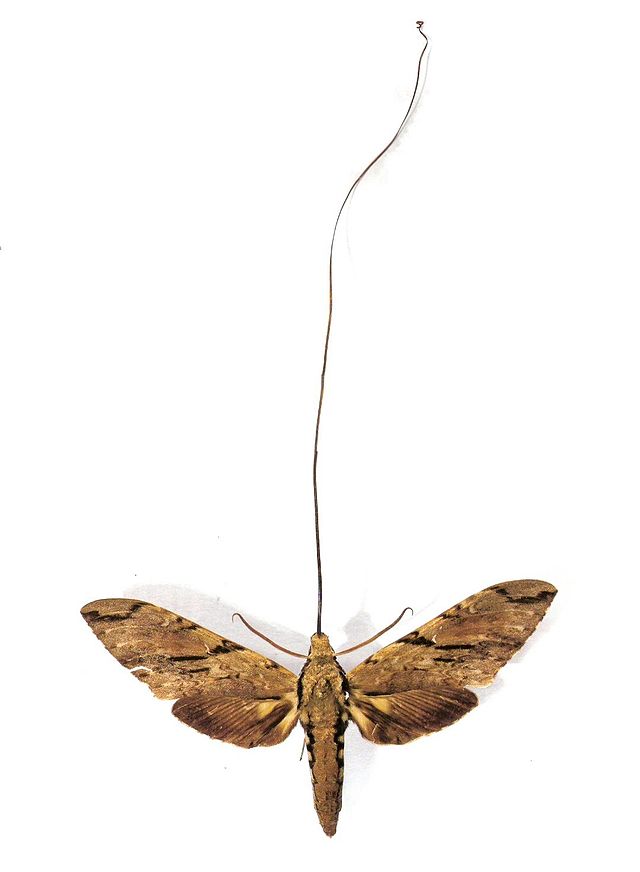
Xanthopan morganii praedicta
Esculapio, Wikimedia Commons, licensed under Creative Commons Attribution-Share Alike 3.0 Unported
In his studies, however, one genus of orchid baffled Darwin. Orchids of the genus Ophrys rarely produced nectar but were clearly adapted to insect pollination. Most curiously, they resembled insects enough to be given common names such as bee orchid or fly orchid. Why these orchids had adopted insectiform mimicry, however, remained unclear. Only sixty years later, in the early 20th century, would naturalists Maurice Pouyanne, Edith Coleman, and Masters John Godfery separately answer this question. All of them observed that Ophrys orchids are indeed pollinated by insects, despite not producing nectar to attract them. Rather, the central petal at the base of the bee orchid specifically resembles the abdomen of a female bee, both in texture and in coloration. Males of the species mistake the orchid for a female bee, land on the petal, and attempt to mate with the flower. As the bee does so, its movements dislodge the orchid’s dense packets of pollen onto the bee, which will fertilize the next Ophrys flower the unwitting insect attempts to mate with. Unlike other orchids that leverage insects’ hunger for nectar, the Ophrys orchids leverage their hunger for sex.
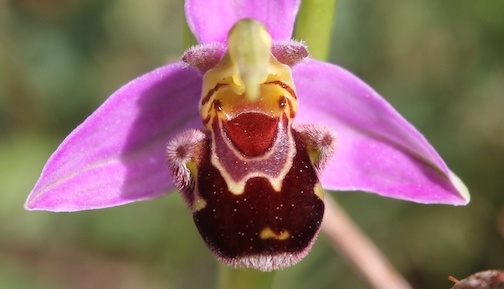
Ophrys apifera labellum, the bee orchid
Hüseyin Cahid Doğan, Wikimedia Commons, licensed under Creative Commons Attribution-Share Alike 4.0 International
Intriguingly, interactions between insects and these orchids were documented by Darwin himself. There are accounts of Ophrys being “attacked” by bees in his 1862 book, though his records read, “The meaning of these attacks, I cannot conjecture.” Though Darwin was making the same observations as the naturalists who would make the discovery sixty years later, he was unable to interpret their significance.
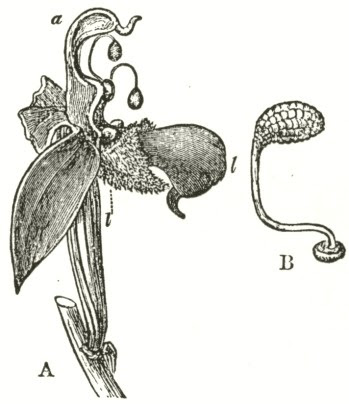
Darwin's original 1862 illustration of Ophrys.
Public domain
Darwin’s struggle to understand Ophrys orchid was likely colored by the “orchidelirium” seizing broader Victorian society at that time. These rare flowers were a luxury commodity accessible only to the very wealthy, with desirable varieties selling for over $20,000 in today’s money. Demand produced a new professional class of orchid hunters, explorers commissioned by rich patrons to go on expeditions into the tropics. While “delirium” implies fevered psychological compulsion, the Victorian appetite for orchids can also be understood as an exercise in wealth, power, and control. Orchid ownership not only signified riches, but connections, education, and taste—a material avenue through which the hierarchies of Victorian England could be expressed.
Nineteenth-century English society was highly stratified along lines of gender and culture, and the principles underlying Darwin’s own work were extrapolated to justify its social hierarchies. The philosophy of Social Darwinism suggested, rather conveniently, that the current social hierarchy was simply the “natural” outcome of applying natural selection and evolution to human society. The philosopher Herbert Spencer, coiner of the phrase “survival of the fittest,” used the metaphor of the body to describe the Victorian hierarchy of gender and class. Upper or middle-class men were the Head, the seat of reason, and thus suited to rule and govern. Women were the Heart, keepers of emotion and spirituality. Notably, botany, particularly the study of flowers, was a culturally sanctioned science for women, intended to socialize them into rationality and industriousness, and away from feminine frivolity. Cultural hierarchies were also used to justify British colonialism as a “civilizing mission” necessary to “assist” colonies to develop sufficiently sophisticated governments and societies. Therefore, orchids, from yet-unexplored regions beyond the empire’s reach, were seen as passive objects to be acquired and cultivated to English tastes.
The process of acquiring orchids only reinforced their place in Victorian hierarchies as exotic objects. The expeditions were dangerous, and orchid hunting was a hypermasculine arena, far from the feminine associations of botany. Orchid hunters ventured to far-flung locales, lured by the promise of fortune and repute, but often met grisly ends. Moreover, the journey of the intrepid orchid hunter into the tropics was not only a physical danger, but a moral one as well. Explorers were entering a space unregulated by English societal norms and morality, with only their own self-control preventing them from being corrupted away from Victorian gentility. While lurid stories of murder and betrayal among orchid hunters resulted from financial competition rather than any tropical corruption, the idea of the tropics as an inherently transgressive space captured the public imagination. Surviving an orchid hunt acted out a cultural narrative of the triumph of civilization over chaos, of English propriety over deviant morality. In return, victors were rewarded with their own personal part of the tropics, a personal stake in the colonial machine. As the empire expanded with growing networks of colonists, missionaries, and traders, exploring and exploiting the tropics became easier. Maps were drawn, dangers were cataloged, and routes were constructed, enabling increased varieties and numbers of orchids to be shipped to England. The once-unattainable orchid was now safely contained in English greenhouses, stripped of its perilous origins, a tamed and civilized ornament.
This view of the orchid, submissive to male impulses and receptive to “civilizing” forces, could certainly present an obstacle to understanding its actively deceptive and manipulative pollination strategies. In fact, the gradual understanding of its actual biology coincided with and may have benefited from a shift in Victorian society. As the reach of the British empire expanded rapidly through the 19th century, so too did cultural anxiety. The Victorian social hierarchy was being challenged both at home and abroad. The word “feminist” entered English usage in the 1890s, with women campaigning for the rights to their own bodily autonomy, such as sexual consent within marriage and the ability to use contraception. Organized anticolonial movements escalated in the latter half of the century, including years-long armed resistance throughout the African continent and mass political mobilization in South Asia. The assured status of the patriarchal empire no longer seemed so certain, and the exoticizing fascination in cultural narratives took on a distinct element of fear.
These growing fears around gender and loss of empire were conflated in a common literary archetype in tropical journey narratives of the 19th century: the “native woman.” She was Other in both race and sex, uncannily seductive, dangerously sensuous, and irrevocably foreign. Previously exotic and passive through the lens of white male protagonists, the “native woman” evolves into something more ominous by the end of the century, often with the help of the orchid. In the pulp magazine story, “The Orchid Horror”, the protagonist is seduced by an unnamed native woman called the Goddess of the Orchids, who sends him to collect an orchid she does not yet have. Upon finding it, he realizes the orchid’s scent is a powerful narcotic, entrapping those who inhale it to the Goddess’s will. Other stories describe secretly carnivorous orchids worn around the necks of native women, or in more literal presentations, monstrous hybrid orchid-women endemic to the tropics. The orchid took on the recurring image of the provocative Other, capable of undermining and subverting hierarchy and social order—the flower as exotic seductress, as femme fatale. The ending of the 1894 short story, “The Flowering of the Strange Orchid,” by science fiction author H.G. Wells lays these anxieties bare: the unsuspecting protagonist is overwhelmed by the orchid’s sickly-sweet scent and is seized by its bloodsucking roots. The orchid he had assumed was a harmless beauty turns out to be a vampiric predator, and he is only saved by his housekeeper, who was suspicious of the overtly foreign bloom. The creeping unease is obvious: what if the subjugated are no longer truly within our control? In this space, so far from the assumptions of Darwin’s Victorian England, an orchid pollinated by providing false sexual promises is no longer far-fetched.
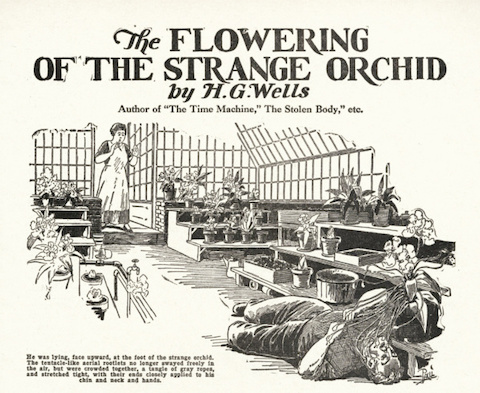
Interior illustration, Amazing Stories, March 1928 by Frank R. Paul
Public domain
The slow discovery of Ophrys pollination illustrates the dialectic of scientific discovery: social context continuously influences the way we do and understand science. Ophrys pollination had to be observed, but it also had to be interpreted. Exactly how it was interpreted was dependent on the social and cultural narratives surrounding it. As science historian Jim Endersby concisely puts it in his book Orchid: A Cultural History, “There is no stable boundary between the natural and the cultural.” For Ophrys pollination to be understood as an act of sexual deception, three intertwined cultural ideas—femininity, foreignness, and flowers—had to be simultaneously reimagined as active subjects instead of passive objects. The destabilization of Victorian society was a powerful catalyst for this reimagination: the greater emancipation of English women and the emergence of organized anticolonial movements challenged what were once thought of as “natural” hierarchies, inspiring reactionary consternation and manifesting as sublimated fears in popular culture like “The Flowering of the Strange Orchid.”
Femininity, seduction, and deception remain entwined with Ophrys pollination even today, and the orchid continues to report on changing, though not necessarily improved, cultural hierarchies: tellingly, some botanists still refer to the bee orchid by another common name: the prostitute flower. While we may prefer to believe that the empirical process of science is completely separated from our sociocultural beliefs, the parallel shifts in the cultural and scientific understanding of orchids tell another story. Like an insect enticed by Ophrys, we labor under a compelling belief, but ultimately an illusory one.




